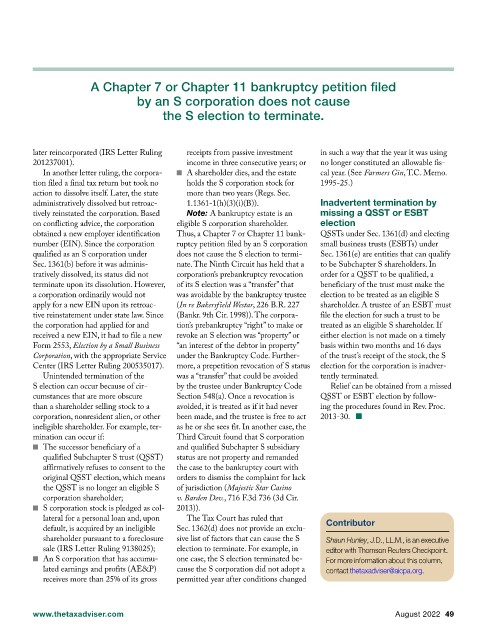Page 432 - TaxAdviser_2022
P. 432
A Chapter 7 or Chapter 11 bankruptcy petition filed
by an S corporation does not cause
the S election to terminate.
later reincorporated (IRS Letter Ruling receipts from passive investment in such a way that the year it was using
201237001). income in three consecutive years; or no longer constituted an allowable fis-
In another letter ruling, the corpora- ■ A shareholder dies, and the estate cal year. (See Farmers Gin, T.C. Memo.
tion filed a final tax return but took no holds the S corporation stock for 1995-25.)
action to dissolve itself. Later, the state more than two years (Regs. Sec.
administratively dissolved but retroac- 1.1361-1(h)(3)(i)(B)). Inadvertent termination by
tively reinstated the corporation. Based Note: A bankruptcy estate is an missing a QSST or ESBT
on conflicting advice, the corporation eligible S corporation shareholder. election
obtained a new employer identification Thus, a Chapter 7 or Chapter 11 bank- QSSTs under Sec. 1361(d) and electing
number (EIN). Since the corporation ruptcy petition filed by an S corporation small business trusts (ESBTs) under
qualified as an S corporation under does not cause the S election to termi- Sec. 1361(e) are entities that can qualify
Sec. 1361(b) before it was adminis- nate. The Ninth Circuit has held that a to be Subchapter S shareholders. In
tratively dissolved, its status did not corporation’s prebankruptcy revocation order for a QSST to be qualified, a
terminate upon its dissolution. However, of its S election was a “transfer” that beneficiary of the trust must make the
a corporation ordinarily would not was avoidable by the bankruptcy trustee election to be treated as an eligible S
apply for a new EIN upon its retroac- (In re Bakersfield Westar, 226 B.R. 227 shareholder. A trustee of an ESBT must
tive reinstatement under state law. Since (Bankr. 9th Cir. 1998)). The corpora- file the election for such a trust to be
the corporation had applied for and tion’s prebankruptcy “right” to make or treated as an eligible S shareholder. If
received a new EIN, it had to file a new revoke an S election was “property” or either election is not made on a timely
Form 2553, Election by a Small Business “an interest of the debtor in property” basis within two months and 16 days
Corporation, with the appropriate Service under the Bankruptcy Code. Further- of the trust’s receipt of the stock, the S
Center (IRS Letter Ruling 200535017). more, a prepetition revocation of S status election for the corporation is inadver-
Unintended termination of the was a “transfer” that could be avoided tently terminated.
S election can occur because of cir- by the trustee under Bankruptcy Code Relief can be obtained from a missed
cumstances that are more obscure Section 548(a). Once a revocation is QSST or ESBT election by follow-
than a shareholder selling stock to a avoided, it is treated as if it had never ing the procedures found in Rev. Proc.
corporation, nonresident alien, or other been made, and the trustee is free to act 2013-30. ■
ineligible shareholder. For example, ter- as he or she sees fit. In another case, the
mination can occur if: Third Circuit found that S corporation
■ The successor beneficiary of a and qualified Subchapter S subsidiary
qualified Subchapter S trust (QSST) status are not property and remanded
affirmatively refuses to consent to the the case to the bankruptcy court with
original QSST election, which means orders to dismiss the complaint for lack
the QSST is no longer an eligible S of jurisdiction (Majestic Star Casino
corporation shareholder; v. Barden Dev., 716 F.3d 736 (3d Cir.
■ S corporation stock is pledged as col- 2013)).
lateral for a personal loan and, upon The Tax Court has ruled that Contributor
default, is acquired by an ineligible Sec. 1362(d) does not provide an exclu-
shareholder pursuant to a foreclosure sive list of factors that can cause the S Shaun Hunley, J.D., LL.M., is an executive
sale (IRS Letter Ruling 9138025); election to terminate. For example, in editor with Thomson Reuters Checkpoint.
■ An S corporation that has accumu- one case, the S election terminated be- For more information about this column,
lated earnings and profits (AE&P) cause the S corporation did not adopt a contact thetaxadviser@aicpa.org.
receives more than 25% of its gross permitted year after conditions changed
www.thetaxadviser.com August 2022 49

